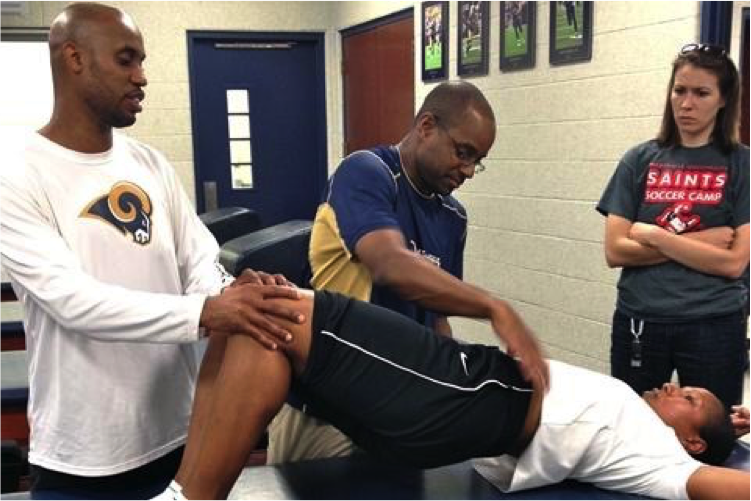Addition by Subtraction
Written by Dr. Lee Burton FMS

If we put a patient through a movement screen and find dysfunction our first reaction is to begin prescribing corrective exercises. After all, the organism is broken, right?
It’s not an incorrect instinct, but it might be incomplete. Rather than just consider how the organism can be improved, it’s important to also consider how the patient’s environment might be contributing to limitations in movement. As Gray said in a recent post, “in my opinion, if the individual doesn’t have a past medical history or pain with movement, I would encourage you to change the environment first.”
 We define environment as the combination of “lifestyle” and “program.” We’re probably familiar with the program, but how much do you know about their lifestyle? Does your patient sit at a desk all day? Do they commute long hours in a car? Are they addicted to their smartphones?
We define environment as the combination of “lifestyle” and “program.” We’re probably familiar with the program, but how much do you know about their lifestyle? Does your patient sit at a desk all day? Do they commute long hours in a car? Are they addicted to their smartphones?
A coach who prescribes corrective exercises without considering the lifestyle is like a nutritionist who writes a meal plan that simply supplements bad eating habits. A kale salad will do little to offset the effect of 3 sodas per day just as 5 minutes of corrective exercises do little to counter 8 hours hunched over a computer.
As the saying goes, “an ounce of prevention is worth a pound of cure.”
The data on the health risks of sitting is unequivocal and indicting. It could be argued that sitting is the new smoking. What’s more concerning is that prescribing correctives isn’t enough to reverse the effects of sitting. As coaches and medical practitioners, we need to looks at removing negative behavior, not just adding positive.
In a study published in May of 2010 in "Medicine and Science in Sports and Exercise", researchers found that men who spent more than 23 hours a week watching TV and sitting in their cars had a 64 percent greater chance of dying from heart disease than those who sat for 11 hours a week or less. That statistic is alarming, but it’s not particularly surprising. What was unexpected, however, is that some data suggests the effects of sitting are relatively unrelated to how much the subjects exercised. Many adults work out regularly, but then they sat for hours and, despite the intermittent exercise, their health still suffered. Their workouts did not counteract the ill effects of sitting. Adding a positive was not enough to counteract a negative.
 In Gray’s recent post about improving ergonomics (“Fitness Tips for Desk Jockeys”), he discussed simple ways soften the effects of a sedentary lifestyle such as monitoring hydration, starting the day with Sun Salutations, and taking walk breaks.
In Gray’s recent post about improving ergonomics (“Fitness Tips for Desk Jockeys”), he discussed simple ways soften the effects of a sedentary lifestyle such as monitoring hydration, starting the day with Sun Salutations, and taking walk breaks.
If you and your client have lofty fitness goals, addressing your environment will help you get there too.
Recently, the BBC and University of Chester studied the effects of standing at our workplace in an attempt to quantify the potential health benefit. The study found that standing caused the volunteers to have a much higher heart rate (around 10 beats per minute higher), which adds up to burning about 50 calories more per hour versus sitting. Over a year, that adds up to about 30,000 more calories or 8 pounds of fat.
Says University of Chester’s Dr John Buckley, "If you want to put that into activity levels, then that would be the equivalent of running about 10 marathons a year. Just by standing up three or four hours in your day at work."
This article certainly isn’t meant to be anti-corrective. The intention of this article is to encourage coaches and medical providers to consider factors outside of their training environment that might be impacting their client’s health and performance. Despite an earnest and well-intentioned emphasis on health and fitness, our society may be guilty of compartmentalizing its efforts to a time slot in our day planner. If our clients are serious about committing to healthier lifestyles, it shouldn’t be something that they are just cramming into their lunch break. Let’s look at how we can change their environment to bring everyone - trainer, therapist and client - closer to their goals.
Related Resources
Please login to leave a comment
4 Comments
-

-

greg weller 2/27/2015 8:11:26 PM
I'm not sure this article is reporting the research correctly. It states;
In addition, high levels of physical activity were related to notably lower rates of CVD death even in the presence of high levels of sedentary behavior.
I think this should be pointed out -

JW 5/22/2015 5:01:59 PM
Funny how they don't mention other behaviors associated with sitting in front of the tv that can increase your risk of heart disease. I wonder how many of those men are drinking beer or eating food high in fat or salt.
-

John Zakharia 1/29/2016 1:34:54 PM
Best article in history. Thank you





